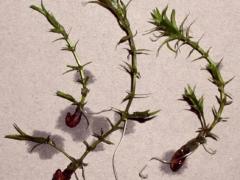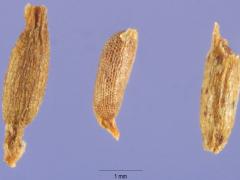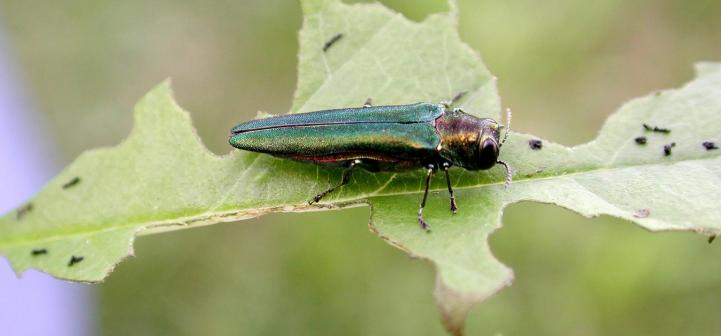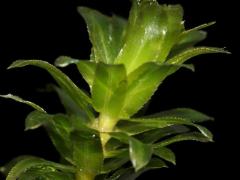Invasive Species: Hydrilla verticillata, Hydrilla
Hydrilla is a submersed, rooted invasive aquatic plant that can grow in water to depths of 20 ft. (6.1 m). Plants can survive in depths to 40 ft. (12 m) in nonturbid water. Leaves are whorled in bunches of three to eight, but most often with whorls of five. The midribs of the leaves are reddish, and the undersides have small, raised teeth. Leaves are 0.2-0.8 in. (5-20 mm) long and less than 0.1 in. (2 mm) wide and have serrated margins. Hydrilla forms dense mats at the surface of the water. The dense mats can restrict native vegetation, irrigation practices, recreation, hydroelectric production, and water flow. This species can invade most slow-moving or still water systems. Hydrilla is believed to be native to Asia or Africa, although it is widely spread across the globe. It was first introduced in North America as an aquarium plant in the 1950s. Hydrilla sometimes is confused with Brazilian egeria (Egeria densa Planch.) and Canadian waterweed (Elodea canadensis Michx.). The leaves of Canadian waterweed occur in whorls of three along the stem and are up to 0.2 in. (5 mm) wide. The midrib of Brazilian egeria is smooth, unlike the toothed midrib of hydrilla.
What are invasive species, and why should we be concerned about them?
Taxonomy: Scientific and Common Names for This Species
Hydrocharitales > Hydrocharitaceae > Hydrilla verticillata (L. f.) Royle
Synonym(s): Florida elodea, water thyme, waterthyme
Hydrilla verticillata – USDA PLANTS Profile
Distribution Maps
Hydrilla – The reported distribution of this invasive species across the United States (Source: Invasive Plant Atlas of the United States)
Up-to-the-minute distribution maps and why they are important
Reporting This Invasive Species
What is the best way to report the occurrence of an invasive species?
How to report an invasive species sighting to EDDMapS – Early Detection & Distribution Mapping System
EDDMapS – Report an invasive species to EDDMapS.
County Extension Offices – Find your local Extension office on this map provided by the USDA.
How to Identify
This invasive species can be identified by looking for the characteristics described in the paragraphs that follow.
Plant
Hydrilla is a submersed, rooted aquatic plant that can grow in water to depths of 20 ft. (6.1 m). Plants can survive in depths to 40 ft. (12 m) in nonturbid water.
 |
 |
| Raghavan Charudattan, University of Florida, bugwood.org | Leslie J. Mehrhoff, University of Connecticut, bugwood.org |
Foliage
Leaves are whorled in bunches of three to eight, but most often with whorls of five. The midribs of the leaves are reddish, and the undersides have small, raised teeth. Leaves are 0.2-0.8 in. (5-20 mm) long and less than 0.1 in. (2 mm) wide and have serrated margins.
|
|
 |
| Robert Vidéki, Doronicum Kft., bugwood.org | Robert Vidéki, Doronicum Kft., bugwood.org |
Flower
| bugwood.org | bugwood.org |
Fruit and Root Tuber
 |
 |
| Steve Hurst, USDA NRCS PLANTS Database, bugwood.org | Robert Vidéki, Doronicum Kft.,bugwood.org |
Native Species That Resemble Hydrilla
– Images at invasive.org
| bugwood.org | bugwood.org |
– Images at invasive.org
| bugwood.org | bugwood.org |
Additional Images for Hydrilla
Hydrilla – Images at invasive.org
Learning Resources for Hydrilla
Hydrilla verticillata Identification Card – US Fish and Wildlife Service
Hydrilla verticillata Fact Sheet – US Fish and Wildlife Service
Additional Information, Biology, Control and Management Resources
Control and management recommendations vary according to individual circumstances. Location, habitat, weather, and a variety of other conditions are factors that help determine the best treatment choice. To find the safest and most effective treatment for your situation, consult your state’s land-grant institution. If you will use chemicals as part of the control process, always refer to the product label.
United States Land-Grant University System – Find your land-grant university’s College of Agriculture, University Cooperative Extension Service, or other related partner on this map provided by USDA.
Fact Sheet – Pennsylvania Department of Conservation and Natural Resources
Plant Invaders of Mid-Atlantic Natural Areas – National Park Service and US Fish and Wildlife Service
Biological Control of Invasive Plants in the Eastern United States – USDA Forest Service
Southeast Exotic Pest Plant Council Invasive Plant Manual – SE-EPPC
Element Stewardship Abstract – The Nature Conservancy
Invasive Plant Atlas of New England – University of Connecticut
Identification and Biology of Non-Native Plants in Florida’s Natural Areas – University of Florida
Hydrilla IPM Project – University of Florida
Federal Noxious Weed Disseminules of the United States – USDA Animal and Plant Health Inspection Service (APHIS)
Weed of the Week – USDA Forest Service
Global Invasive Species Database – Invasive Species Specialist Group

